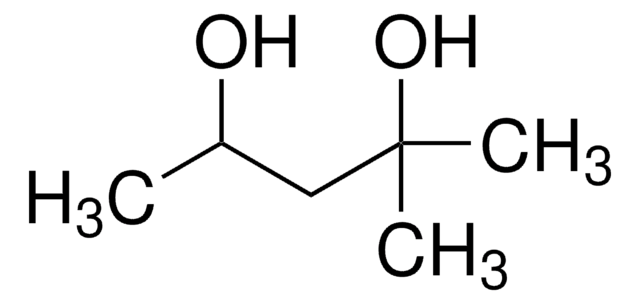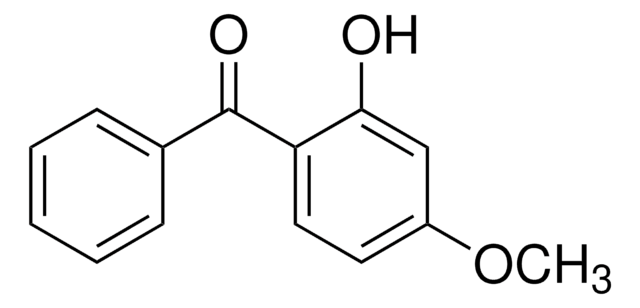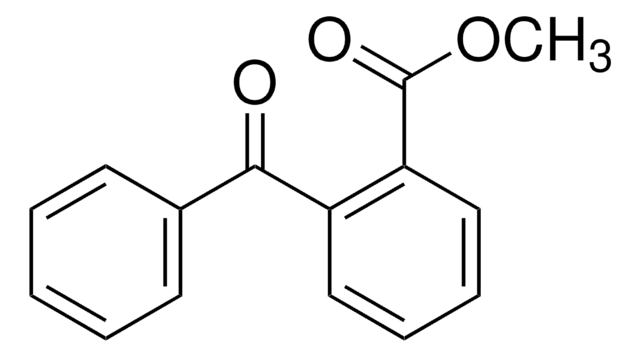437395
2-Ethylhexyl 4-(dimethylamino)benzoate
98%
Sinônimo(s):
2-Ethylhexyl 4-(N ,N -dimethylamino)benzoate, 2-Ethylhexyl 4-(dimethylamino)benzoate, 2-Ethylhexyl N ,N -dimethyl-p -aminobenzoate, 2-Ethylhexyl p -(dimethylamino)benzoate, 4-(Dimethylamino)benzoic acid 2-ethylhexyl ester, EHDAB, Octyl dimethyl PABA
About This Item
Produtos recomendados
Ensaio
98%
forma
liquid
índice de refração
n20/D 1.542 (lit.)
pb
325 °C (lit.)
densidade
0.995 g/mL at 25 °C (lit.)
cadeia de caracteres SMILES
CCCCC(CC)COC(=O)c1ccc(cc1)N(C)C
InChI
1S/C17H27NO2/c1-5-7-8-14(6-2)13-20-17(19)15-9-11-16(12-10-15)18(3)4/h9-12,14H,5-8,13H2,1-4H3
chave InChI
WYWZRNAHINYAEF-UHFFFAOYSA-N
Procurando produtos similares? Visita Guia de comparação de produtos
Descrição geral
Aplicação
- Study of the photochemical transformation of 2-ethylhexyl 4-(dimethylamino) benzoate (OD-PABA) under conditions relevant to surface waters: This research investigates the photochemical behavior and transformation products of 2-ethylhexyl 4-(dimethylamino)benzoate in aquatic environments, highlighting its environmental impact (Calza et al., 2016).
- Photoprotection or photodamage: a direct observation of nonradiative dynamics from 2-ethylhexyl 4-dimethylaminobenzoate sunscreen agent: The paper provides insights into the nonradiative dynamics of 2-ethylhexyl 4-dimethylaminobenzoate, assessing its effectiveness as a sunscreen agent and potential for photodamage (Ma et al., 2018).
- Bioaccumulation and biomagnification of 2-ethylhexyl-4-dimethylaminobenzoate in aquatic animals: This study examines the bioaccumulation and biomagnification potential of 2-ethylhexyl-4-dimethylaminobenzoate in aquatic organisms, providing valuable data on its environmental persistence and effects (Lu et al., 2018).
Palavra indicadora
Danger
Frases de perigo
Declarações de precaução
Classificações de perigo
Repr. 1B
Código de classe de armazenamento
6.1C - Combustible acute toxic Cat.3 / toxic compounds or compounds which causing chronic effects
Classe de risco de água (WGK)
WGK 2
Ponto de fulgor (°F)
374.0 °F - closed cup
Ponto de fulgor (°C)
190 °C - closed cup
Equipamento de proteção individual
Eyeshields, Gloves, type ABEK (EN14387) respirator filter
Escolha uma das versões mais recentes:
Já possui este produto?
Encontre a documentação dos produtos que você adquiriu recentemente na biblioteca de documentos.
Os clientes também visualizaram
Nossa equipe de cientistas tem experiência em todas as áreas de pesquisa, incluindo Life Sciences, ciência de materiais, síntese química, cromatografia, química analítica e muitas outras.
Entre em contato com a assistência técnica











![2,2′-Metilenobis[6-(2H-benzotriazol-2-il)-4-(1,1,3,3-tetrametilbutil)fenol] analytical standard](/deepweb/assets/sigmaaldrich/product/structures/236/824/ce89085c-b9e1-4ea0-8157-44b6f9466ed6/640/ce89085c-b9e1-4ea0-8157-44b6f9466ed6.png)
